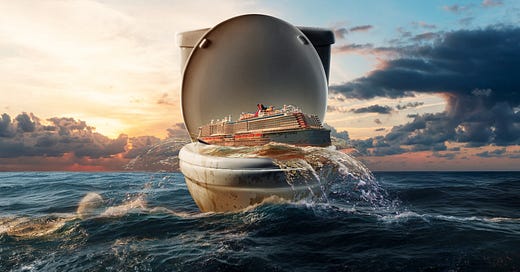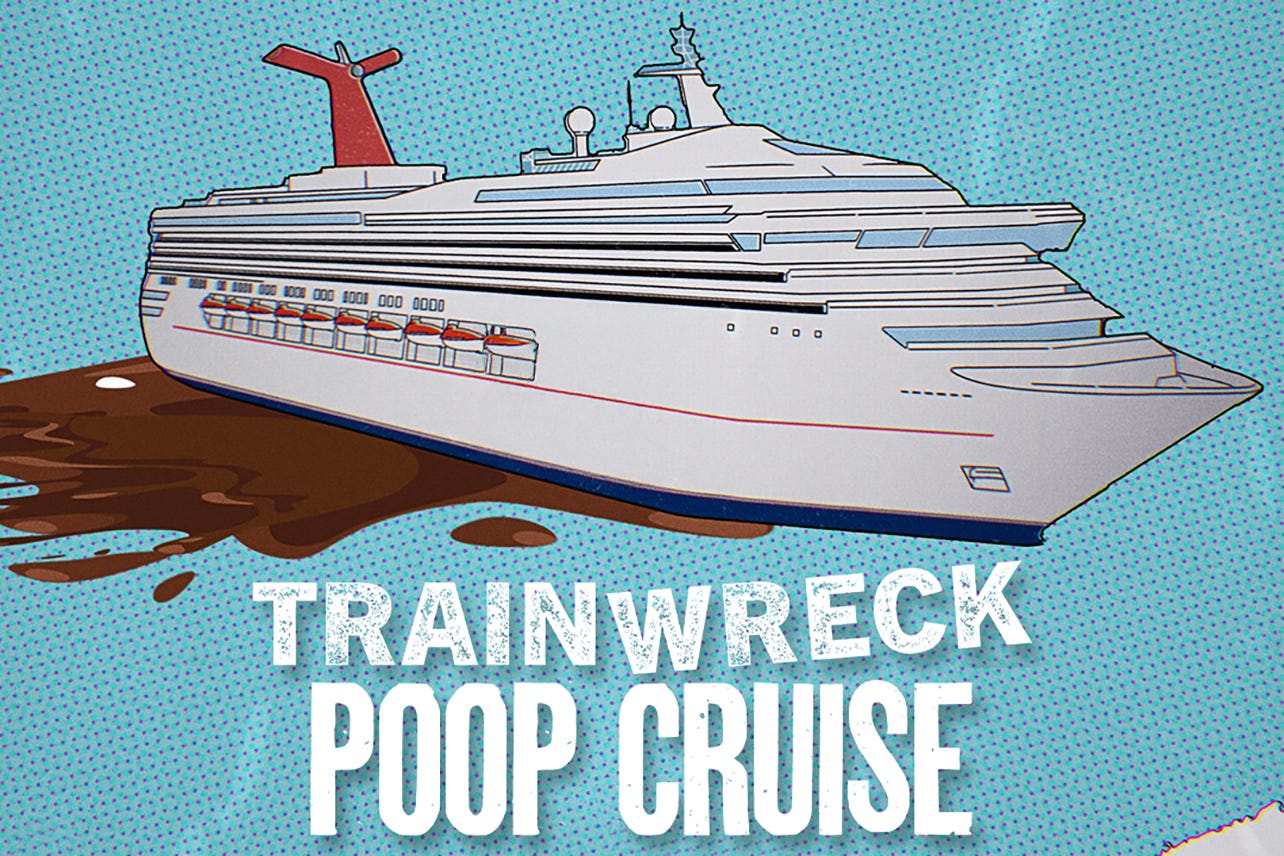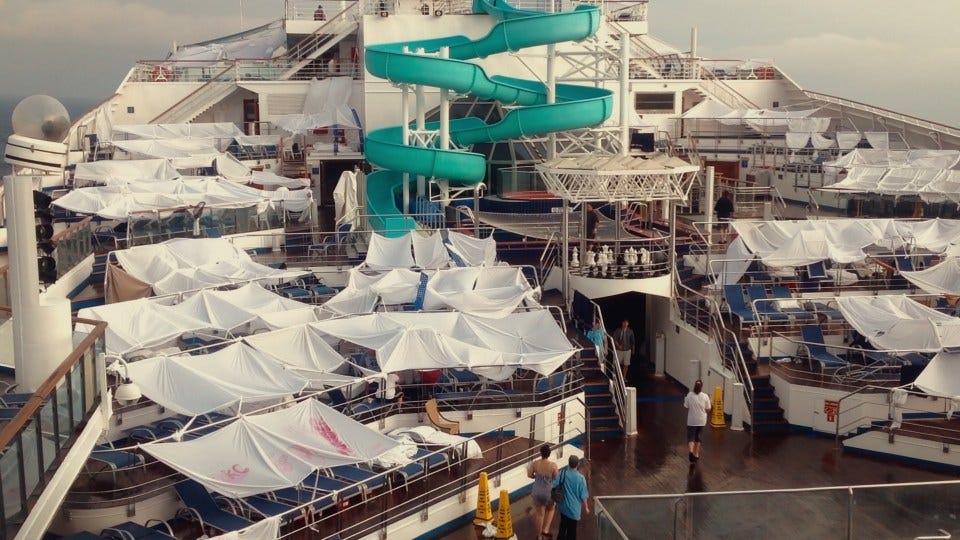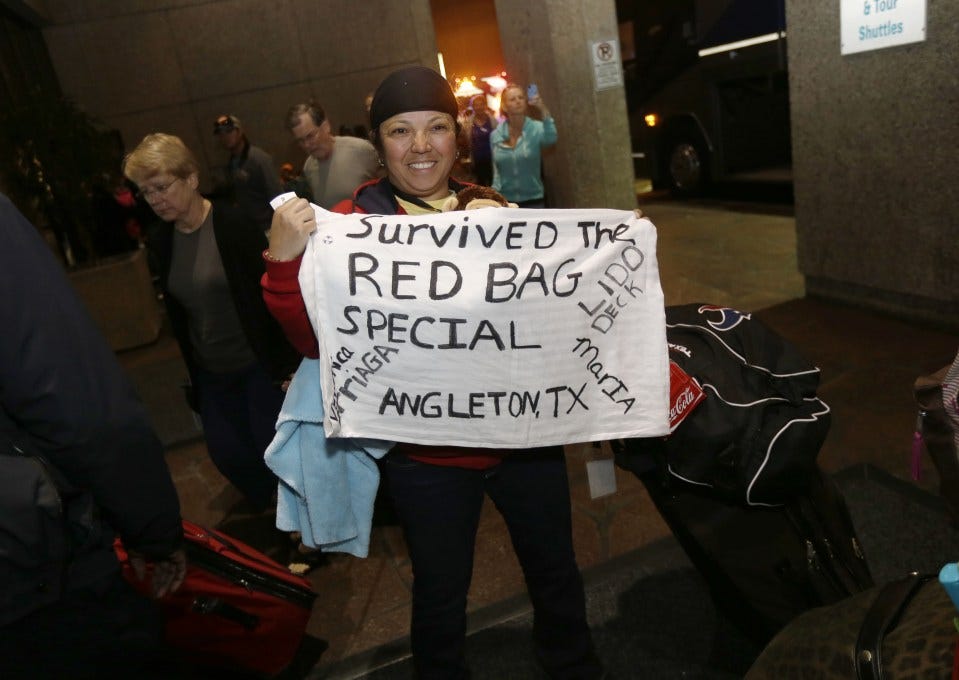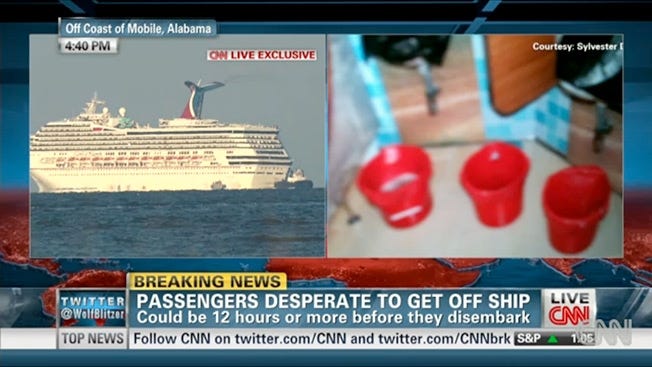🛳 Carnival’s PR Didn’t Sink in 2013. It Sh*t Itself.
And Netflix just made sure we’ll never forget it.
When I was 9 years old, I embarked on my very first cruise vacation. My mom (Carole, who many of you know, love, and worry about every hurricane season), my cousin Alysha, and I set sail on the Carnival Triumph back in 1999—when hair wraps were the pinnacle of a vacation souvenir and smoking indoors was still legal, chic, and encouraged via laminated restaurant menus.
We went to Cozumel, Grand Cayman, and Ocho Rios. My cousin, who was one year older than me, somehow landed a cruise ship boyfriend named Danny (??? I think) for the week. He was on vacation with his family. It was a big deal, however, because Danny dropped the ball (as 10-year-olds do) and she’s now happily married with two beautiful children. As for me? I was there for four things: unlimited ice cream, snorkeling, swimming with manta rays, and the pool.
So why am I telling you about my pre-teen sunburn-and-soft-serve cruise era? Because that exact ship—the Carnival Triumph—would go on to become the antagonist in what the internet lovingly dubbed the Poop Cruise. The very vessel that gave me my first taste of tropical freedom went full Titanic-meets-Taco-Bell twelve years later, when it caught fire, lost power, and stranded over 4,000 passengers in the Gulf of Mexico for nearly a week, with no electricity, overflowing toilets, and literal human waste sloshing through the hallways.
And Carnival? They handled it like a brand that thought a complimentary mimosa could fix the smell of sewage.
This isn’t just a trip down memory lane. It’s a PR postmortem with a splash of septic. Because what happened on that ship in 2013 wasn’t just a mechanical failure. It was a communications failure of epic proportions. And if you’ve ever wondered how not to handle a crisis, Carnival’s Poop Cruise debacle is the masterclass in what not to do.
Netflix just released a new documentary called Trainwreck: Poop Cruise—and watching it brought everything back with a vengeance. The chaos. The silence. The red bags. And it’s not just dredging up the past for shock value. The documentary dropped the same week Carnival quietly overhauled its loyalty program, scrapping lifetime perks and asking top-tier customers to spend $33K every two years just to keep their Diamond status. The backlash? Immediate. Brutal. And eerily familiar. Because passengers didn’t just feel overlooked in 2013. They feel overlooked now.
And the way the doc locks it all in amber: from the moment a passenger got a signal and hit "send"—it was, as one crew member puts it, a complete media bloodbath.
Let’s break this down.
🚨 The Incident™️
In February 2013, an engine fire knocked out power on the Carnival Triumph, leaving it adrift in the Gulf. Toilets stopped working. Air conditioning failed. Food supplies dwindled. Passengers were instructed to defecate into plastic bags and urinate in showers. Tents were erected on deck. People slept in hallways. One woman reportedly developed a UTI from holding her bladder too long. News outlets dubbed it a “floating hell.”
Photos from passengers showed red biohazard bags lining the hallways. Others camped out on upper decks under sheets to escape the sewage and heat below. At one point, stranded passengers used towels to spell out the word “HELP” on the top deck, and when they finally disembarked, some literally kissed the ground. One woman waved a towel that read “Survived the RED BAG SPECIAL.”
It didn’t take long for the media frenzy to begin. Cellphone videos and texts leaked online once the ship passed close enough to another Carnival vessel to get a signal. And once passengers were able to contact loved ones, the story exploded on social media. Hashtags like #CruiseFromHell and #poopcruise started trending, and cable news went full apocalypse mode. CNN ran wall-to-wall coverage. Fox, NBC, everyone had anchors narrating every mile of the ship’s slow, humiliating tow into Mobile, Alabama.
The Netflix doc features reenactments of passengers lighting up their phones as soon as they found Wi-Fi—some crouched by lifeboats, others crowding the deck. One crew member, describing the state of the bathrooms, famously calls it "poop lasagna." It’s funny until it isn’t. Because what it really reveals is just how unprepared Carnival was for the optics, the outrage, and the receipts.
🧻 The Real Failure Wasn’t the Fire
Carnival couldn’t have prevented the engine fire, but they absolutely could’ve managed the fallout better.
Where they really went wrong was framing it from the start as a minor issue aboard their cruise ship when it very clearly was not. The moment passengers regained access to Wi-Fi and could contact their loved ones—who, understandably, were extremely worried—those messages started spreading. Quickly. Firsthand accounts, photos, and horror stories circulated across social media in real time. And once that happens? You no longer own the narrative.
When other people are telling your story for you, you’ve already lost control.
That’s how they ended up with the hashtag—#cruiseshipfromhell—and from there, the internet took the wheel.
This was the inflection point for modern brand crises. It wasn’t just a mechanical failure—it was a failure to understand that in the era of smartphones and social media, narrative control doesn’t belong to you anymore. It belongs to your customers. And if you don’t speak first, fast, and human? The internet will tell your story for you—and they’ll make it smell worse than the hallways on deck 7.
🤡 Where Carnival Blew It
Delayed response: Carnival waited too long to release detailed updates or acknowledge the severity of the situation. When the story is going viral and the sewage is going literal, speed matters.
Corporate tone-deafness: The initial statements were bland and bureaucratic, heavy on liability-avoidance, light on humanity. They even responded to one tweet during the incident with, “Of course the bathrobes for the Carnival Triumph are complimentary.”
I’m sorry, your passengers are hovering over shower drains like drunk college girls in the dive bar bathroom on ladies night. What.
Invisible leadership: CEO Gerry Cahill eventually issued an apology, but Carnival’s chairman, Micky Arison, was spotted courtside at a Miami Heat game while the disaster unfolded. When your ship’s being towed into port on live TV and your owner is watching basketball, that’s what we in the business call…a bad look.
Insulting reparations: Carnival offered passengers a refund, $500, transportation reimbursements, and a voucher for a future cruise. That’s right—they invited traumatized guests to come back for more.
Babe, read the room.
Carnival’s response read like it was written by a legal team duct-taping empathy onto a spreadsheet. The moment the power died, so did the narrative. One backed-up pipe, and Carnival’s whole comms strategy got flushed.
💡 What They Should Have Done
This wasn’t just a brand crisis. It was a full-blown bodily-function breakdown—with a corporate shrug on top. And every good comms pro knows: in the absence of leadership, people will fill the silence with speculation—and memes.
If I were advising Carnival in real time? Here’s what the strategy should’ve looked like by hour six:
A daily live update from a C-suite exec—not a junior PR rep behind a firewall.
Coordinated family liaison teams with real-time updates via SMS/email to next-of-kin.
A branded crisis microsite updating hourly, with honest language (yes, even about the toilets).
A preemptive tweet: “Yes, this is awful. Yes, we’re working nonstop. No, we won’t ask you to cruise again until we fix this.”
Because the difference between a good apology and a bad one? A good apology centers the people harmed, leads with accountability, and comes with changed behavior. A bad one centers liability, smooths it over with vague regret, and prays the news cycle moves on. Carnival gave us what I call apology theater—a corporate performance no one believed, everyone booed, and Legal gave a standing ovation.
They needed:
Real-time transparency
Passenger-first messaging
To own the name Poop Cruise before Twitter did
Instead, they tried to outlast the news cycle. But honey…shit floats. And so does bad PR.
💸 The $115 Million Glow-Up
In 2018, Carnival quietly spent $115 million to rehab the Triumph and rebranded it as the Carnival Sunrise. They also conducted $300 million in fleet-wide upgrades after the disaster. But by then, the damage was done.
You can change the name. You can swap out the carpets. But Google doesn’t forget.
And let’s be honest: no amount of onboard Guy Fieri burgers or rooftop mini-golf can erase the image of passengers holding up “HELP” signs while floating through the Gulf in what basically amounted to a septic-themed escape room.
This isn’t just about one cruise ship. It’s a lesson for every brand: Don’t wait for your crisis to go viral before you start telling the truth. Because once the memes take over, it’s no longer your story.
It’s theirs. And if you’re gonna make people poop in bags? You better damn well have a better apology than a future cruise voucher.
🧼 What This Was Really About
This wasn’t a freak accident. It was the cruise industry’s culture of containment over care.
Carnival wasn’t just cleaning up sewage—they were cleaning up years of deferred maintenance, failed safety checks, and a crisis strategy built on silence and spin.
And now? They’re doing it again.
The loyalty program backlash isn’t just about perks—it’s about trust. About being told your years of loyalty don’t matter unless you keep paying. And the fact that they announced these wildly unpopular changes the same week Netflix dropped a poop cruise documentary?
That wasn’t bad timing. It was calculated distraction. A classic bait-and-switch: bury the betrayal in a news cycle already full of chaos and comedy.
But here's the thing: you can win the quarter and still lose the long game. Especially when your customers feel disposable.
Carnival’s mistake wasn’t just the change—it was the timing, the tone, and the assumption that nobody would notice. That no one would care. That we’d all be too busy laughing at poop lasagna to see the pattern.
If your brand is facing a painful change or public blowback, don’t try to sneak it past your audience. Lead with transparency. Be early, be honest, and be human.
Containment doesn’t work. Not with sewage. Not with stories. And definitely not with people.
Because people notice. People remember. And now, thanks to Netflix, they never forget.
If you made it to the end of this post without dry heaving or rage-tweeting about corporate accountability, congrats. You’re now qualified to run crisis comms for a Fortune 500.
If you laughed, learned something, or just feel slightly less alone in this unflushed content economy, smash that subscribe button like it’s a red biohazard bag labeled “for PR use only.”
🧻 Want help figuring out what to say when the vibes are off, the DMs are wild, you’re one misstep away from a public apology, or you just really need help from someone with a PR brain on the cheap? Book a WTF Do I Say Right Now? session. It’s 60 minutes of strategic messaging support for when your nervous system and your audience are both on high alert.
Already subscribed? You’re my kind of unhinged. Forward this to someone who’s been hovering over “draft” for three days and just needs a sign from the content gods.
Paid subs = donations to the Unhinged Publicist Fund™. They come with my love, affection, and the spiritual equivalent of holding your hair back while you try to statement-draft your way through a disaster.
See you in the group chat.
xo,
Beth


